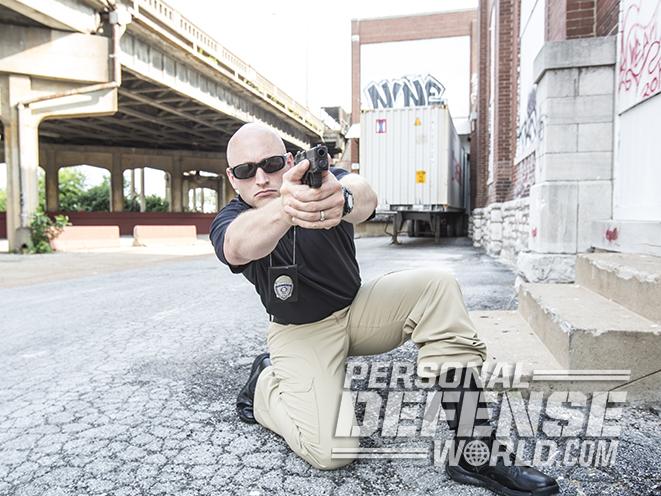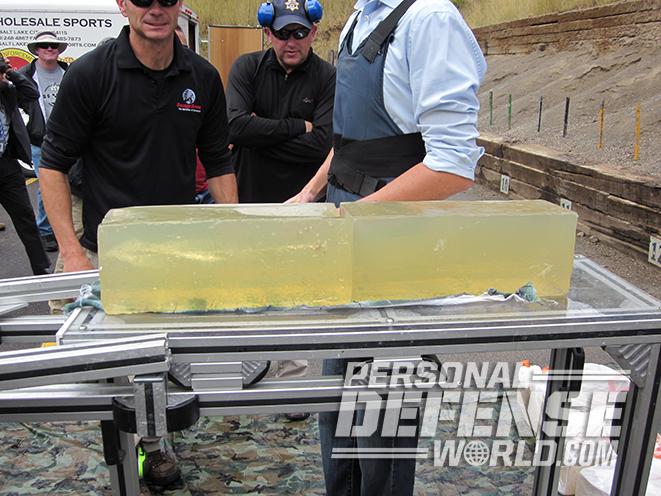On the Internet, in some gun shops and even in training seminars, we have for some time heard the mantra, “All service pistol chamberings are equal in so-called ‘stopping power.’” Sometimes you’ll hear, “The 9mm and .40 S&W and .45 ACP are all the same on the downrange end.”
True or false? Well, if the answer to that were simple, we wouldn’t still be debating it. To gain a foundation for understanding, the first thing we have to do is look at the history of each chambering.
9mm Origins
Advertisement — Continue Reading Below

The 9mm—aka the 9mm Luger, 9mm Parabellum and 9x19mm—came onto the scene in 1902 to answer concerns that the German P-08 pistol’s original 7.65x21mm cartridge (.30 Luger) of 1900 had insufficient stopping power. Essentially, the 9mm comprised case-head dimensions of the bottlenecked .30 Luger blown out to take a bullet 0.355 inches in diameter. By the end of the 20th century, this new round would become the most popular military pistol cartridge around the world.
As he neared the end of his life, John Moses Browning created a double-stack magazine that could take more of the narrower 9mm cartridges in a service-sized frame. He died before Dieudonné Saive, his protégé at the Belgium company of Fabrique Nationale, finalized the design that would become the historic Browning Hi-Power in 1935. It held 13 cartridges in its standard magazine and a 14th in its chamber.
Shortly thereafter, Walther in Germany introduced the P38, a 9mm with a single-stack, eight-round magazine and a long double-action (DA) trigger for the first shot. This, in theory, meant that the user didn’t need to rack a round into the chamber before shooting, nor thumb off a safety catch, thus theoretically allowing for a faster first shot. The P38 design would become the template for S&W’s first police service 9mm, the Model 39, and for the later, higher-capacity Italian Beretta Model 92.
Advertisement — Continue Reading Below
The first major American law enforcement agency to adopt the 9mm was the Illinois State Police (ISP) in 1967. The ISP’s head of ordnance, Louis Seman, noted that off-duty troopers and plainclothes detectives were shooting dismal scores with their small-framed, 2-inch-barreled .38 Special and .357 Magnum service revolvers. He convinced his superintendent that the flat, light, easy-to-carry Model 39 would serve both roles superbly. Perhaps because the Model 39 went to an easy single-action (SA) trigger pull after the first shot, scores went up for all but the top revolver shooters after the adoption of the 9mm pistol, and more importantly, the hit potential soared from the typical “one hit per four shots in real gunfights with revolvers” to a high 60th percentile.
In the late 1970s, I was the feature editor of “Illinois Trooper” magazine, the publication of Troopers Lodge #41 of the Fraternal Order of Police, the bargaining agent for the troopers in question. The revolver-versus-auto issue was significant among working street cops then, and with the cooperation of the ISP itself, we did a survey of the troopers. We found that a high percentage of the troops on the road at the time would prefer either a .45 ACP semi-auto or a .357 Magnum revolver.
The biggest reason was that they were dissatisfied with the 9mm ammunition of the time. The agency had started with full-metal-jacket (FMJ) “ball” ammunition, and there had not been a single instant, one-shot stop unless the bullet had pierced the central nervous system of the offender. Switching to soft-nose bullets was an improvement, but except for one muzzle-contact shot that had forced explosive muzzle blast into the liver of the would-be cop-killer, there had still been no one-shot stops that had not struck the brain or spinal cord. The department went through more than one hollow-point cartridge until it hit upon the formula that made the concept work: a 115-grain +P+ round traveling at 1,300 fps, as produced by Winchester and Federal.
Advertisement — Continue Reading Below
Other police agencies did not start widely adopting the 9mm until the early 1980s. The usual load was a 115-grain jacketed hollow point (JHP) rated for standard (not +P or +P+) velocities. Not long after the highly publicized 1986 FBI shootout in Miami in which two agents died, three more were permanently injured and another two sustained lesser wounds, the Bureau gathered experts to analyze what might work better. In that shootout, a standard-velocity, 115-grain 9mm had inflicted a presumably un-survivable wound on one of the suspects, but the bullet had failed to reach the heart at a lateral angle that passed through the killer’s arm.
Dr. Martin Fackler, the U.S. Army’s head of wound ballistics at the Letterman Institute at the Presidio pointed out that the 147-grain, subsonic Winchester Olin Super Match (OSM) round, developed for Special Forces units to deliver headshots from distance with great accuracy from integrally sound-suppressed HK MP5 submachine guns, would have penetrated deeper according to lab testing with a new ballistic gelatin formula he developed. The FBI adopted this load, and much of the nation’s police—now deep into the switch to semi-automatic pistols largely due to their greater firepower—followed suit.
Browning’s .45 ACP
Advertisement — Continue Reading Below

The .45 Automatic Colt Pistol (ACP) cartridge was first conceptualized by the great John Moses Browning circa 1903, and it first appeared in the Colt Model 1905 pistol. An ungainly thing that resembled a T-square with a gland condition, the Model 1905 never caught on or established any reputation as a gunfighting tool. That did not come until Browning’s vastly improved Model 1911 aced military tests and was adopted in its eponymous year. The military had insisted on a .45-caliber duty cartridge due to numerous “stopping failures” with the .38 Long Colt service revolver in use in the Philippines.
The new .45 ACP proved itself in 1915 when Herman Hanneken, a U.S. Marine, killed guerilla leader Charlemagne Perrault in Haiti, and during General Pershing’s expedition against Pancho Villa the following year. However, it was World War I that made the .45’s reputation. In the savage hand-to-hand combat that occurred in the trenches, the .45 ACP worked so well that General Pershing wanted every American doughboy armed with a 1911. Colt couldn’t keep up with that much demand on its autopistol production line, however, and S&W and Colt .45 ACP revolvers were introduced in 1917 to fill the gap.
Veterans returned from WWI with an appreciation for the .45 ACP. Anecdotal stories held that the .45 ACP dropped German soldiers rapidly, but the Germans’ 9mm Lugers did not act so swiftly upon even mortally wounded Americans.
Advertisement — Continue Reading Below
Texas Rangers were probably the first to pick up on the .45 ACP for law enforcement. Unfortunately, criminals picked up on it, too. The “motorized bandits” of the Depression years favored them, notably Baby Face Nelson, John Dillinger, Pretty Boy Floyd and Clyde Barrow. More cops began using .45s: Charles Winstead, of the fledgling agency that would become the FBI, killed Dillinger with a .45 ACP.
The .45 ACP’s reputation was reinforced by veterans of the Vietnam conflict, the last major war in which that caliber was standard issue for soldiers who wore handguns into combat. Yet in the Middle East, from the 1990s through today, some .45s were in the hands of elite military operators while 9mms were standard issue, both with FMJs. There would be some who came home from “the sandbox” saying the 9mm was every bit as good as the .45 ACP, and some who said the .45 ACP clearly outclassed the 9mm. Interestingly, none seemed to say that the 9mm, shot for shot, stopped enemy fighters better than the .45 ACP.
Birth Of The .40
Advertisement — Continue Reading Below

As the sea change from .38 Special/.357 Magnum service revolvers surged through the 1980s, America’s police found themselves with a collision of preferences. Some cops figured if they were going to go from their trusted old six-shooters to semi-autos, they wanted lots more bullets, which meant 16-shot 9mms. Others felt that if they had to go from their powerful .357 Magnum revolvers to autoloaders, they wanted .45s.
Nowhere was this starker than in the FBI, where there were role model agents and firearms instructors on both sides. The higher-capacity 9mm faction was presumably led by Bill Vanderpool, while Urey Patrick headed the larger-caliber contingent. In the middle was John Hall, head of the Bureau’s Firearms Training Unit. Hall researched the matter intensively and determined that the 10mm Auto cartridge, somewhat downloaded from its maximum potential, might be the ideal answer. A 10mm pistol could hold more rounds than a .45 in roughly the same-sized package while being powerful enough to satisfy large-caliber devotees. It cut the Gordian Knot of the matter, creating a middle ground where each faction could say, “We got what we wanted for our people.”
The 10mm “FBI load” comprised a 180-grain JHP rated for 1,000 fps. Designed to work in .45 ACP-sized handgun platforms—the Colt Delta Elite 1911 in 10mm had been the initial test gun—it necessitated a large-framed pistol. The FBI specified and then adopted the S&W Model 1076, essentially the same overall pistol platform of S&W’s DA/SA .45 ACPs. The FBI adopted the 10mm circa 1989. Contrary to Internet gun lore, Bureau agents did not have trouble controlling the recoil of the full-power 10mm, resulting in the adoption of a “minus-P” load; rather, Hall and his team determined prior to issuance that the 180-grain bullet at some 1,000 fps would meet their specific needs of penetration with expansion and controllability in rapid fire.
Advertisement — Continue Reading Below
- RELATED STORY: Top Fightin’ .40s – 15 Proven & Reliable .40 S&W Handguns
With a standard nine-round magazine and a 10th cartridge in the chamber—and extended backup magazines to be issued to each agent—the Model 1076 was a major step forward from the previous S&W Model 13 service revolver. A 10mm bullet weighing 180 grains was very close to the most popular police .45 ACP load of the period, a 185-grain hollow point at a nominal velocity of up to 1,000 fps. Thus, the 10mm seemed to strike an ideal middle ground between the needs of the higher-capacity faction and the larger-caliber faction.
However, being the same overall length as a .45 ACP, the 10mm needed a grip frame that was long front to back, and the Model 1076 was a heavy, all-stainless-steel pistol. As the 10mm seemed destined for sudden huge popularity thanks to the FBI’s adoption, others behind the scenes were working with the cartridge. Paul Liebenberg and Whit Collins had done the primary design work, and Tom Campbell at S&W along with Ed Hobbe worked on adapting it to S&W’s double-stack 9mm Model 5906. The result was a “10mm Short” cartridge called the .40 S&W, and it jointly debuted with S&W’s Model 4006 pistol and Winchester’s 180-grain JHP load at a nominal 1,010 fps.
Many departments saw this as the ultimate compromise. The traditional capacity of a .45 ACP had been 7+1 rounds while most double-stack 9mms held 15+1 rounds. The Model 4006 held 11+1 rounds—exactly in the middle between the 9mm and .45 ACP, and exactly twice the capacity of a sixgun. Glock immediately created the Glock 22, a .40-caliber version of its popular 9mm Glock 17. Because of its different geometry, the Glock 22 could hold 15+1 rounds. Seen by many as the best of both worlds, it quickly became the most popular police pistol, followed by similar designs such as the S&W Sigma of 1993 and the S&W M&P40 introduced approximately a decade later.
Advertisement — Continue Reading Below
In more than a quarter century of the 9mm, .40 S&W and .45 ACP being simultaneously in the field, some collective experience has accumulated. We’ll get to that next.
This article was originally published in ‘The Complete Book of Handguns’ 2017. For information on how to subscribe, visit outdoorgroupstore.com.































